A Reflective Essay on Patient's Experience
VerifiedAdded on 2023/06/04
|9
|2382
|308
AI Summary
This reflective essay discusses the importance of patient-centric care and the need for nursing professionals to prioritize patients. It also highlights the negative impact of neglecting patient safety and the importance of adhering to national standards. The essay concludes with an action plan for improving patient-centric care.
Contribute Materials
Your contribution can guide someone’s learning journey. Share your
documents today.
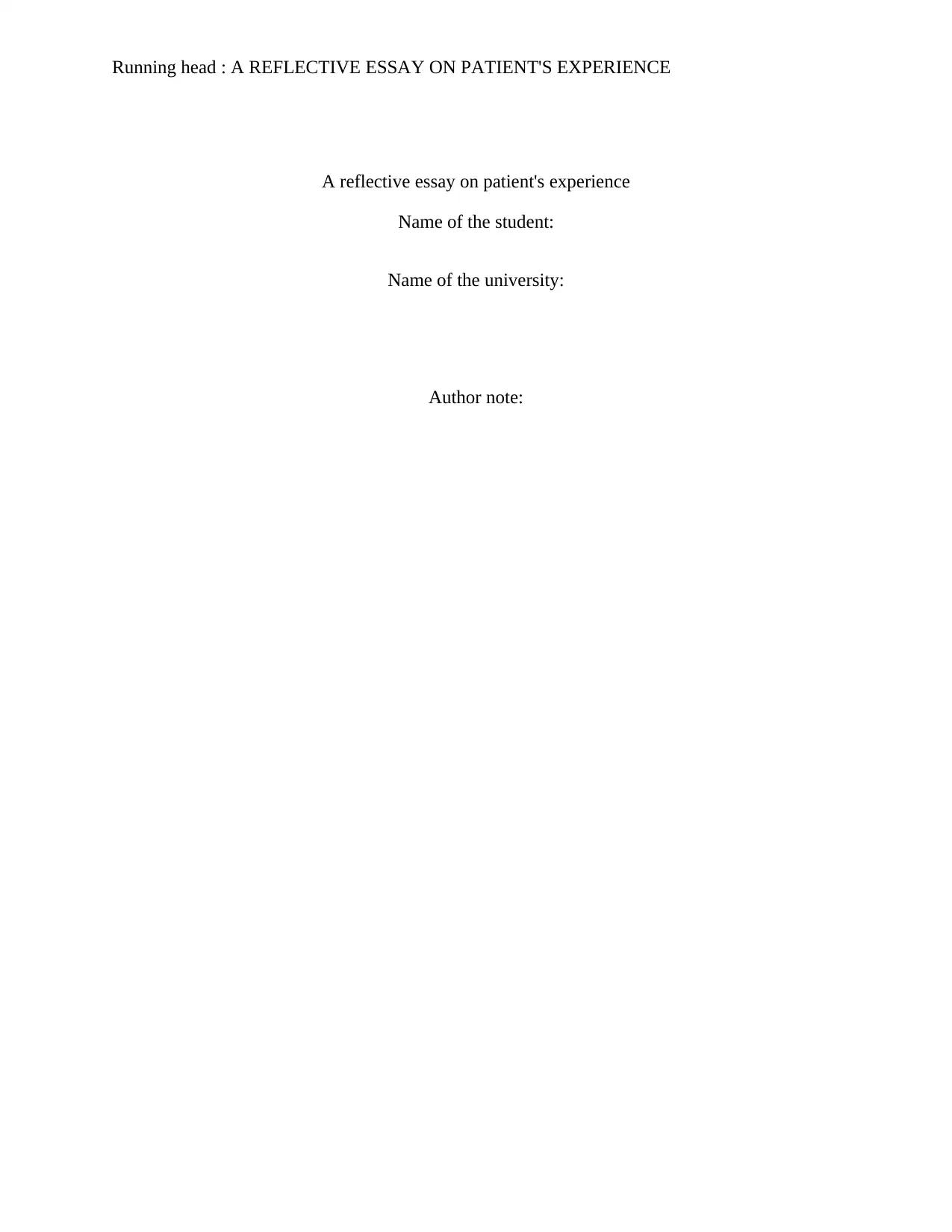
Running head : A REFLECTIVE ESSAY ON PATIENT'S EXPERIENCE
A reflective essay on patient's experience
Name of the student:
Name of the university:
Author note:
A reflective essay on patient's experience
Name of the student:
Name of the university:
Author note:
Secure Best Marks with AI Grader
Need help grading? Try our AI Grader for instant feedback on your assignments.
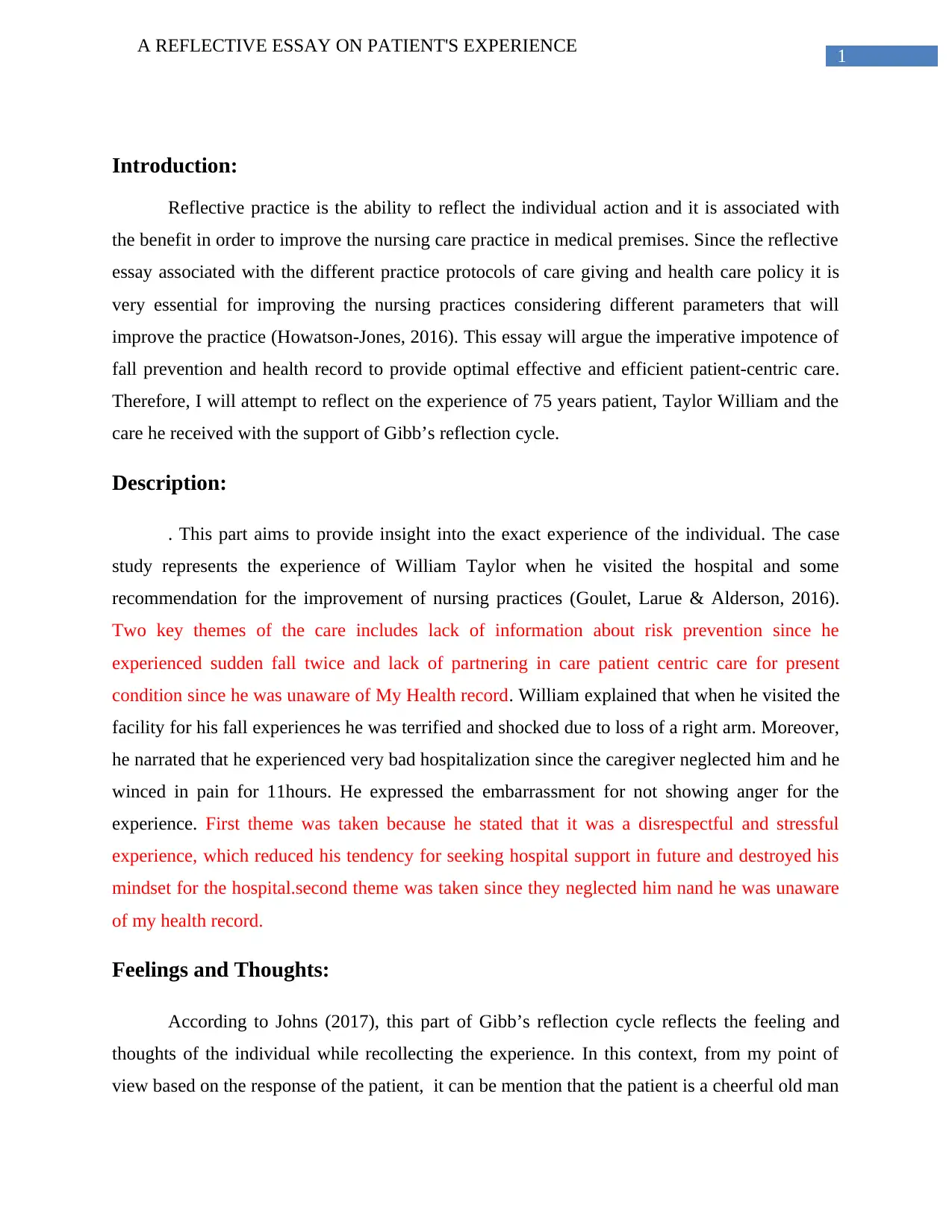
1
A REFLECTIVE ESSAY ON PATIENT'S EXPERIENCE
Introduction:
Reflective practice is the ability to reflect the individual action and it is associated with
the benefit in order to improve the nursing care practice in medical premises. Since the reflective
essay associated with the different practice protocols of care giving and health care policy it is
very essential for improving the nursing practices considering different parameters that will
improve the practice (Howatson-Jones, 2016). This essay will argue the imperative impotence of
fall prevention and health record to provide optimal effective and efficient patient-centric care.
Therefore, I will attempt to reflect on the experience of 75 years patient, Taylor William and the
care he received with the support of Gibb’s reflection cycle.
Description:
. This part aims to provide insight into the exact experience of the individual. The case
study represents the experience of William Taylor when he visited the hospital and some
recommendation for the improvement of nursing practices (Goulet, Larue & Alderson, 2016).
Two key themes of the care includes lack of information about risk prevention since he
experienced sudden fall twice and lack of partnering in care patient centric care for present
condition since he was unaware of My Health record. William explained that when he visited the
facility for his fall experiences he was terrified and shocked due to loss of a right arm. Moreover,
he narrated that he experienced very bad hospitalization since the caregiver neglected him and he
winced in pain for 11hours. He expressed the embarrassment for not showing anger for the
experience. First theme was taken because he stated that it was a disrespectful and stressful
experience, which reduced his tendency for seeking hospital support in future and destroyed his
mindset for the hospital.second theme was taken since they neglected him nand he was unaware
of my health record.
Feelings and Thoughts:
According to Johns (2017), this part of Gibb’s reflection cycle reflects the feeling and
thoughts of the individual while recollecting the experience. In this context, from my point of
view based on the response of the patient, it can be mention that the patient is a cheerful old man
A REFLECTIVE ESSAY ON PATIENT'S EXPERIENCE
Introduction:
Reflective practice is the ability to reflect the individual action and it is associated with
the benefit in order to improve the nursing care practice in medical premises. Since the reflective
essay associated with the different practice protocols of care giving and health care policy it is
very essential for improving the nursing practices considering different parameters that will
improve the practice (Howatson-Jones, 2016). This essay will argue the imperative impotence of
fall prevention and health record to provide optimal effective and efficient patient-centric care.
Therefore, I will attempt to reflect on the experience of 75 years patient, Taylor William and the
care he received with the support of Gibb’s reflection cycle.
Description:
. This part aims to provide insight into the exact experience of the individual. The case
study represents the experience of William Taylor when he visited the hospital and some
recommendation for the improvement of nursing practices (Goulet, Larue & Alderson, 2016).
Two key themes of the care includes lack of information about risk prevention since he
experienced sudden fall twice and lack of partnering in care patient centric care for present
condition since he was unaware of My Health record. William explained that when he visited the
facility for his fall experiences he was terrified and shocked due to loss of a right arm. Moreover,
he narrated that he experienced very bad hospitalization since the caregiver neglected him and he
winced in pain for 11hours. He expressed the embarrassment for not showing anger for the
experience. First theme was taken because he stated that it was a disrespectful and stressful
experience, which reduced his tendency for seeking hospital support in future and destroyed his
mindset for the hospital.second theme was taken since they neglected him nand he was unaware
of my health record.
Feelings and Thoughts:
According to Johns (2017), this part of Gibb’s reflection cycle reflects the feeling and
thoughts of the individual while recollecting the experience. In this context, from my point of
view based on the response of the patient, it can be mention that the patient is a cheerful old man
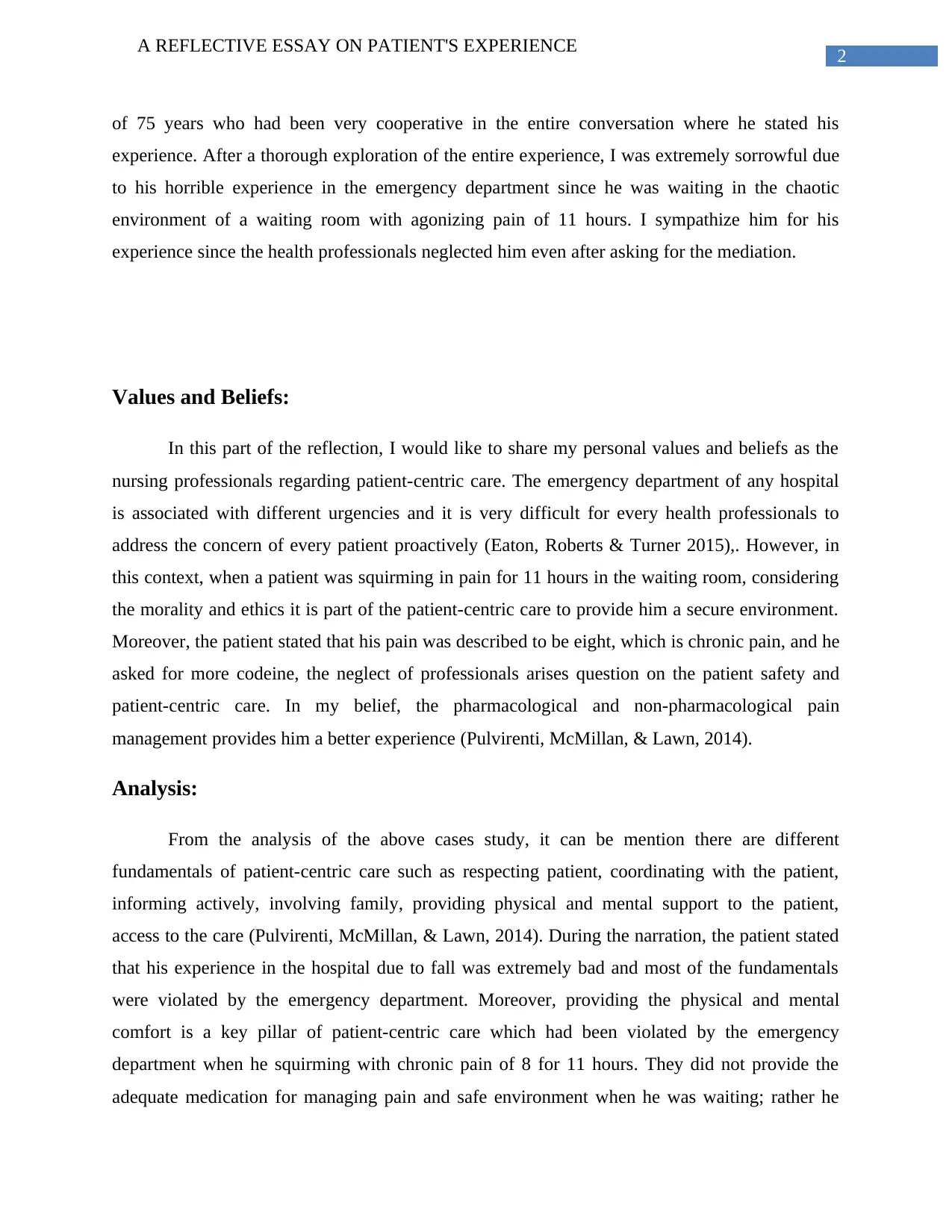
2
A REFLECTIVE ESSAY ON PATIENT'S EXPERIENCE
of 75 years who had been very cooperative in the entire conversation where he stated his
experience. After a thorough exploration of the entire experience, I was extremely sorrowful due
to his horrible experience in the emergency department since he was waiting in the chaotic
environment of a waiting room with agonizing pain of 11 hours. I sympathize him for his
experience since the health professionals neglected him even after asking for the mediation.
Values and Beliefs:
In this part of the reflection, I would like to share my personal values and beliefs as the
nursing professionals regarding patient-centric care. The emergency department of any hospital
is associated with different urgencies and it is very difficult for every health professionals to
address the concern of every patient proactively (Eaton, Roberts & Turner 2015),. However, in
this context, when a patient was squirming in pain for 11 hours in the waiting room, considering
the morality and ethics it is part of the patient-centric care to provide him a secure environment.
Moreover, the patient stated that his pain was described to be eight, which is chronic pain, and he
asked for more codeine, the neglect of professionals arises question on the patient safety and
patient-centric care. In my belief, the pharmacological and non-pharmacological pain
management provides him a better experience (Pulvirenti, McMillan, & Lawn, 2014).
Analysis:
From the analysis of the above cases study, it can be mention there are different
fundamentals of patient-centric care such as respecting patient, coordinating with the patient,
informing actively, involving family, providing physical and mental support to the patient,
access to the care (Pulvirenti, McMillan, & Lawn, 2014). During the narration, the patient stated
that his experience in the hospital due to fall was extremely bad and most of the fundamentals
were violated by the emergency department. Moreover, providing the physical and mental
comfort is a key pillar of patient-centric care which had been violated by the emergency
department when he squirming with chronic pain of 8 for 11 hours. They did not provide the
adequate medication for managing pain and safe environment when he was waiting; rather he
A REFLECTIVE ESSAY ON PATIENT'S EXPERIENCE
of 75 years who had been very cooperative in the entire conversation where he stated his
experience. After a thorough exploration of the entire experience, I was extremely sorrowful due
to his horrible experience in the emergency department since he was waiting in the chaotic
environment of a waiting room with agonizing pain of 11 hours. I sympathize him for his
experience since the health professionals neglected him even after asking for the mediation.
Values and Beliefs:
In this part of the reflection, I would like to share my personal values and beliefs as the
nursing professionals regarding patient-centric care. The emergency department of any hospital
is associated with different urgencies and it is very difficult for every health professionals to
address the concern of every patient proactively (Eaton, Roberts & Turner 2015),. However, in
this context, when a patient was squirming in pain for 11 hours in the waiting room, considering
the morality and ethics it is part of the patient-centric care to provide him a secure environment.
Moreover, the patient stated that his pain was described to be eight, which is chronic pain, and he
asked for more codeine, the neglect of professionals arises question on the patient safety and
patient-centric care. In my belief, the pharmacological and non-pharmacological pain
management provides him a better experience (Pulvirenti, McMillan, & Lawn, 2014).
Analysis:
From the analysis of the above cases study, it can be mention there are different
fundamentals of patient-centric care such as respecting patient, coordinating with the patient,
informing actively, involving family, providing physical and mental support to the patient,
access to the care (Pulvirenti, McMillan, & Lawn, 2014). During the narration, the patient stated
that his experience in the hospital due to fall was extremely bad and most of the fundamentals
were violated by the emergency department. Moreover, providing the physical and mental
comfort is a key pillar of patient-centric care which had been violated by the emergency
department when he squirming with chronic pain of 8 for 11 hours. They did not provide the
adequate medication for managing pain and safe environment when he was waiting; rather he
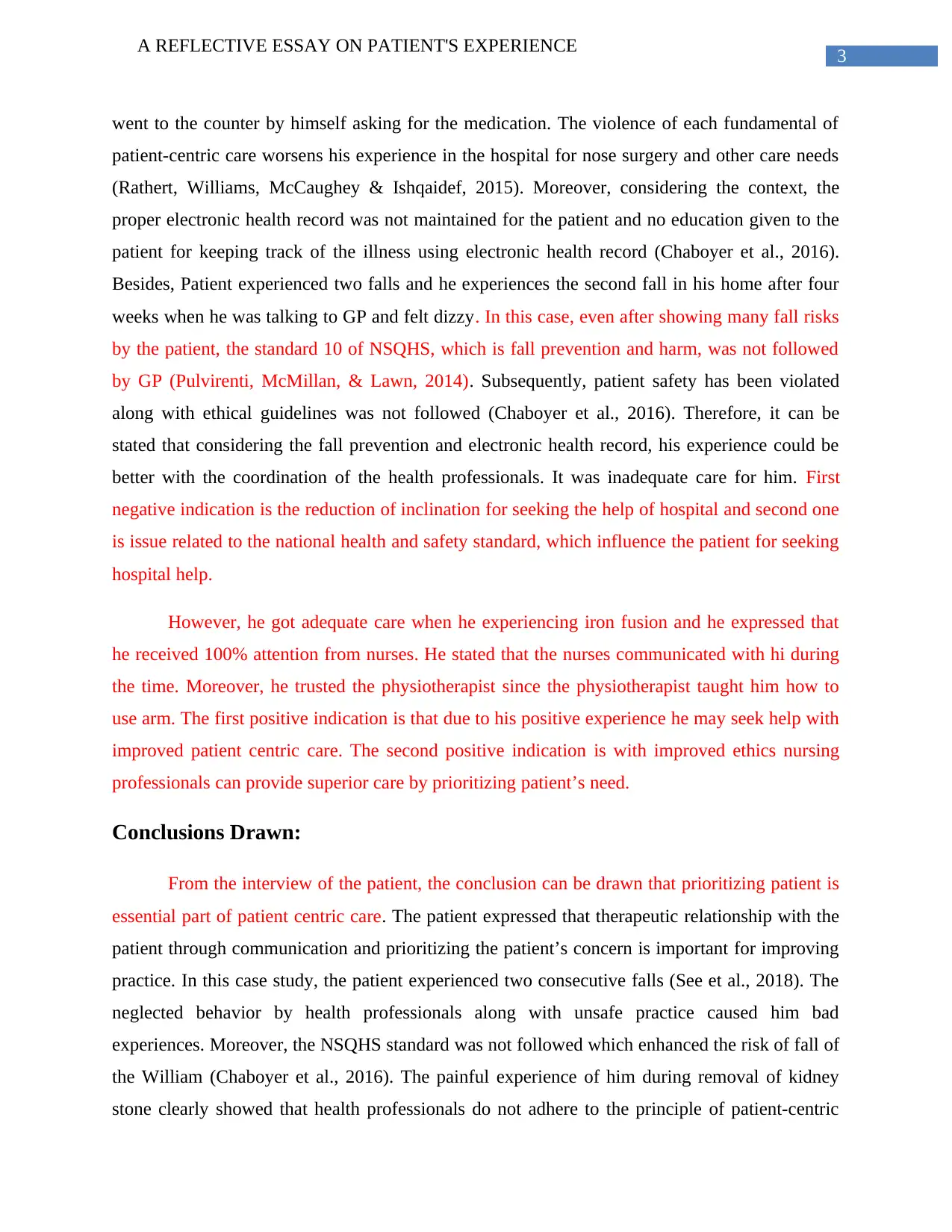
3
A REFLECTIVE ESSAY ON PATIENT'S EXPERIENCE
went to the counter by himself asking for the medication. The violence of each fundamental of
patient-centric care worsens his experience in the hospital for nose surgery and other care needs
(Rathert, Williams, McCaughey & Ishqaidef, 2015). Moreover, considering the context, the
proper electronic health record was not maintained for the patient and no education given to the
patient for keeping track of the illness using electronic health record (Chaboyer et al., 2016).
Besides, Patient experienced two falls and he experiences the second fall in his home after four
weeks when he was talking to GP and felt dizzy. In this case, even after showing many fall risks
by the patient, the standard 10 of NSQHS, which is fall prevention and harm, was not followed
by GP (Pulvirenti, McMillan, & Lawn, 2014). Subsequently, patient safety has been violated
along with ethical guidelines was not followed (Chaboyer et al., 2016). Therefore, it can be
stated that considering the fall prevention and electronic health record, his experience could be
better with the coordination of the health professionals. It was inadequate care for him. First
negative indication is the reduction of inclination for seeking the help of hospital and second one
is issue related to the national health and safety standard, which influence the patient for seeking
hospital help.
However, he got adequate care when he experiencing iron fusion and he expressed that
he received 100% attention from nurses. He stated that the nurses communicated with hi during
the time. Moreover, he trusted the physiotherapist since the physiotherapist taught him how to
use arm. The first positive indication is that due to his positive experience he may seek help with
improved patient centric care. The second positive indication is with improved ethics nursing
professionals can provide superior care by prioritizing patient’s need.
Conclusions Drawn:
From the interview of the patient, the conclusion can be drawn that prioritizing patient is
essential part of patient centric care. The patient expressed that therapeutic relationship with the
patient through communication and prioritizing the patient’s concern is important for improving
practice. In this case study, the patient experienced two consecutive falls (See et al., 2018). The
neglected behavior by health professionals along with unsafe practice caused him bad
experiences. Moreover, the NSQHS standard was not followed which enhanced the risk of fall of
the William (Chaboyer et al., 2016). The painful experience of him during removal of kidney
stone clearly showed that health professionals do not adhere to the principle of patient-centric
A REFLECTIVE ESSAY ON PATIENT'S EXPERIENCE
went to the counter by himself asking for the medication. The violence of each fundamental of
patient-centric care worsens his experience in the hospital for nose surgery and other care needs
(Rathert, Williams, McCaughey & Ishqaidef, 2015). Moreover, considering the context, the
proper electronic health record was not maintained for the patient and no education given to the
patient for keeping track of the illness using electronic health record (Chaboyer et al., 2016).
Besides, Patient experienced two falls and he experiences the second fall in his home after four
weeks when he was talking to GP and felt dizzy. In this case, even after showing many fall risks
by the patient, the standard 10 of NSQHS, which is fall prevention and harm, was not followed
by GP (Pulvirenti, McMillan, & Lawn, 2014). Subsequently, patient safety has been violated
along with ethical guidelines was not followed (Chaboyer et al., 2016). Therefore, it can be
stated that considering the fall prevention and electronic health record, his experience could be
better with the coordination of the health professionals. It was inadequate care for him. First
negative indication is the reduction of inclination for seeking the help of hospital and second one
is issue related to the national health and safety standard, which influence the patient for seeking
hospital help.
However, he got adequate care when he experiencing iron fusion and he expressed that
he received 100% attention from nurses. He stated that the nurses communicated with hi during
the time. Moreover, he trusted the physiotherapist since the physiotherapist taught him how to
use arm. The first positive indication is that due to his positive experience he may seek help with
improved patient centric care. The second positive indication is with improved ethics nursing
professionals can provide superior care by prioritizing patient’s need.
Conclusions Drawn:
From the interview of the patient, the conclusion can be drawn that prioritizing patient is
essential part of patient centric care. The patient expressed that therapeutic relationship with the
patient through communication and prioritizing the patient’s concern is important for improving
practice. In this case study, the patient experienced two consecutive falls (See et al., 2018). The
neglected behavior by health professionals along with unsafe practice caused him bad
experiences. Moreover, the NSQHS standard was not followed which enhanced the risk of fall of
the William (Chaboyer et al., 2016). The painful experience of him during removal of kidney
stone clearly showed that health professionals do not adhere to the principle of patient-centric
Secure Best Marks with AI Grader
Need help grading? Try our AI Grader for instant feedback on your assignments.
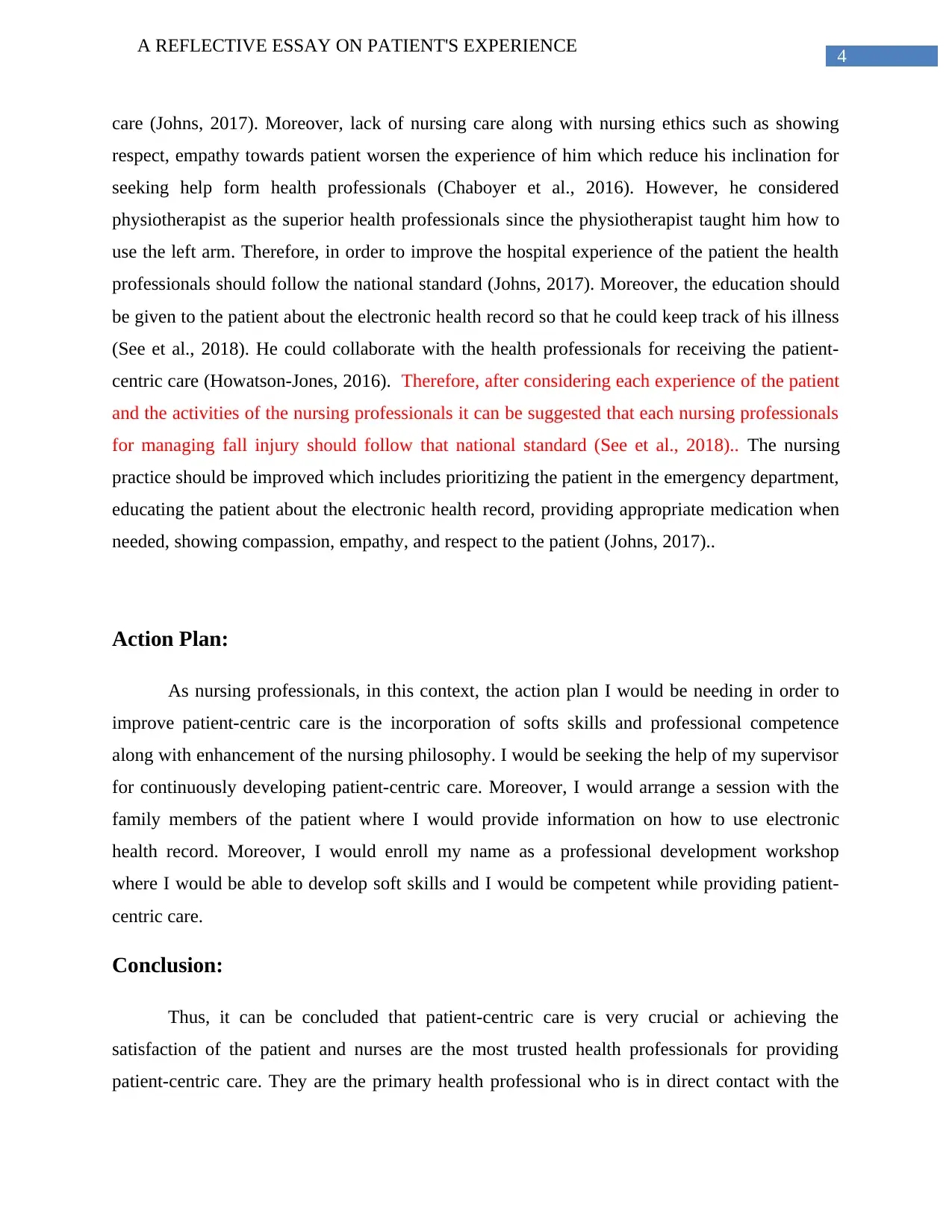
4
A REFLECTIVE ESSAY ON PATIENT'S EXPERIENCE
care (Johns, 2017). Moreover, lack of nursing care along with nursing ethics such as showing
respect, empathy towards patient worsen the experience of him which reduce his inclination for
seeking help form health professionals (Chaboyer et al., 2016). However, he considered
physiotherapist as the superior health professionals since the physiotherapist taught him how to
use the left arm. Therefore, in order to improve the hospital experience of the patient the health
professionals should follow the national standard (Johns, 2017). Moreover, the education should
be given to the patient about the electronic health record so that he could keep track of his illness
(See et al., 2018). He could collaborate with the health professionals for receiving the patient-
centric care (Howatson-Jones, 2016). Therefore, after considering each experience of the patient
and the activities of the nursing professionals it can be suggested that each nursing professionals
for managing fall injury should follow that national standard (See et al., 2018).. The nursing
practice should be improved which includes prioritizing the patient in the emergency department,
educating the patient about the electronic health record, providing appropriate medication when
needed, showing compassion, empathy, and respect to the patient (Johns, 2017)..
Action Plan:
As nursing professionals, in this context, the action plan I would be needing in order to
improve patient-centric care is the incorporation of softs skills and professional competence
along with enhancement of the nursing philosophy. I would be seeking the help of my supervisor
for continuously developing patient-centric care. Moreover, I would arrange a session with the
family members of the patient where I would provide information on how to use electronic
health record. Moreover, I would enroll my name as a professional development workshop
where I would be able to develop soft skills and I would be competent while providing patient-
centric care.
Conclusion:
Thus, it can be concluded that patient-centric care is very crucial or achieving the
satisfaction of the patient and nurses are the most trusted health professionals for providing
patient-centric care. They are the primary health professional who is in direct contact with the
A REFLECTIVE ESSAY ON PATIENT'S EXPERIENCE
care (Johns, 2017). Moreover, lack of nursing care along with nursing ethics such as showing
respect, empathy towards patient worsen the experience of him which reduce his inclination for
seeking help form health professionals (Chaboyer et al., 2016). However, he considered
physiotherapist as the superior health professionals since the physiotherapist taught him how to
use the left arm. Therefore, in order to improve the hospital experience of the patient the health
professionals should follow the national standard (Johns, 2017). Moreover, the education should
be given to the patient about the electronic health record so that he could keep track of his illness
(See et al., 2018). He could collaborate with the health professionals for receiving the patient-
centric care (Howatson-Jones, 2016). Therefore, after considering each experience of the patient
and the activities of the nursing professionals it can be suggested that each nursing professionals
for managing fall injury should follow that national standard (See et al., 2018).. The nursing
practice should be improved which includes prioritizing the patient in the emergency department,
educating the patient about the electronic health record, providing appropriate medication when
needed, showing compassion, empathy, and respect to the patient (Johns, 2017)..
Action Plan:
As nursing professionals, in this context, the action plan I would be needing in order to
improve patient-centric care is the incorporation of softs skills and professional competence
along with enhancement of the nursing philosophy. I would be seeking the help of my supervisor
for continuously developing patient-centric care. Moreover, I would arrange a session with the
family members of the patient where I would provide information on how to use electronic
health record. Moreover, I would enroll my name as a professional development workshop
where I would be able to develop soft skills and I would be competent while providing patient-
centric care.
Conclusion:
Thus, it can be concluded that patient-centric care is very crucial or achieving the
satisfaction of the patient and nurses are the most trusted health professionals for providing
patient-centric care. They are the primary health professional who is in direct contact with the
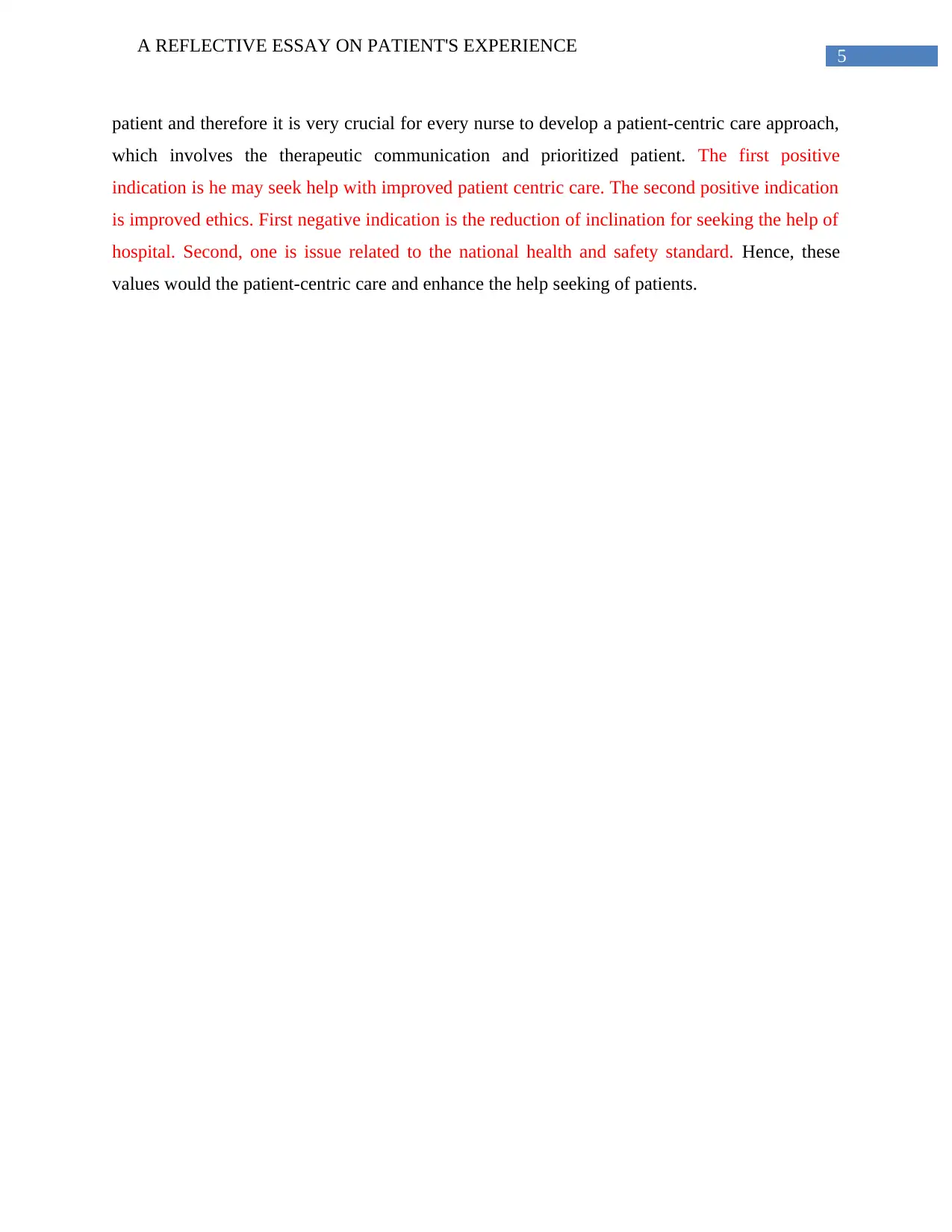
5
A REFLECTIVE ESSAY ON PATIENT'S EXPERIENCE
patient and therefore it is very crucial for every nurse to develop a patient-centric care approach,
which involves the therapeutic communication and prioritized patient. The first positive
indication is he may seek help with improved patient centric care. The second positive indication
is improved ethics. First negative indication is the reduction of inclination for seeking the help of
hospital. Second, one is issue related to the national health and safety standard. Hence, these
values would the patient-centric care and enhance the help seeking of patients.
A REFLECTIVE ESSAY ON PATIENT'S EXPERIENCE
patient and therefore it is very crucial for every nurse to develop a patient-centric care approach,
which involves the therapeutic communication and prioritized patient. The first positive
indication is he may seek help with improved patient centric care. The second positive indication
is improved ethics. First negative indication is the reduction of inclination for seeking the help of
hospital. Second, one is issue related to the national health and safety standard. Hence, these
values would the patient-centric care and enhance the help seeking of patients.
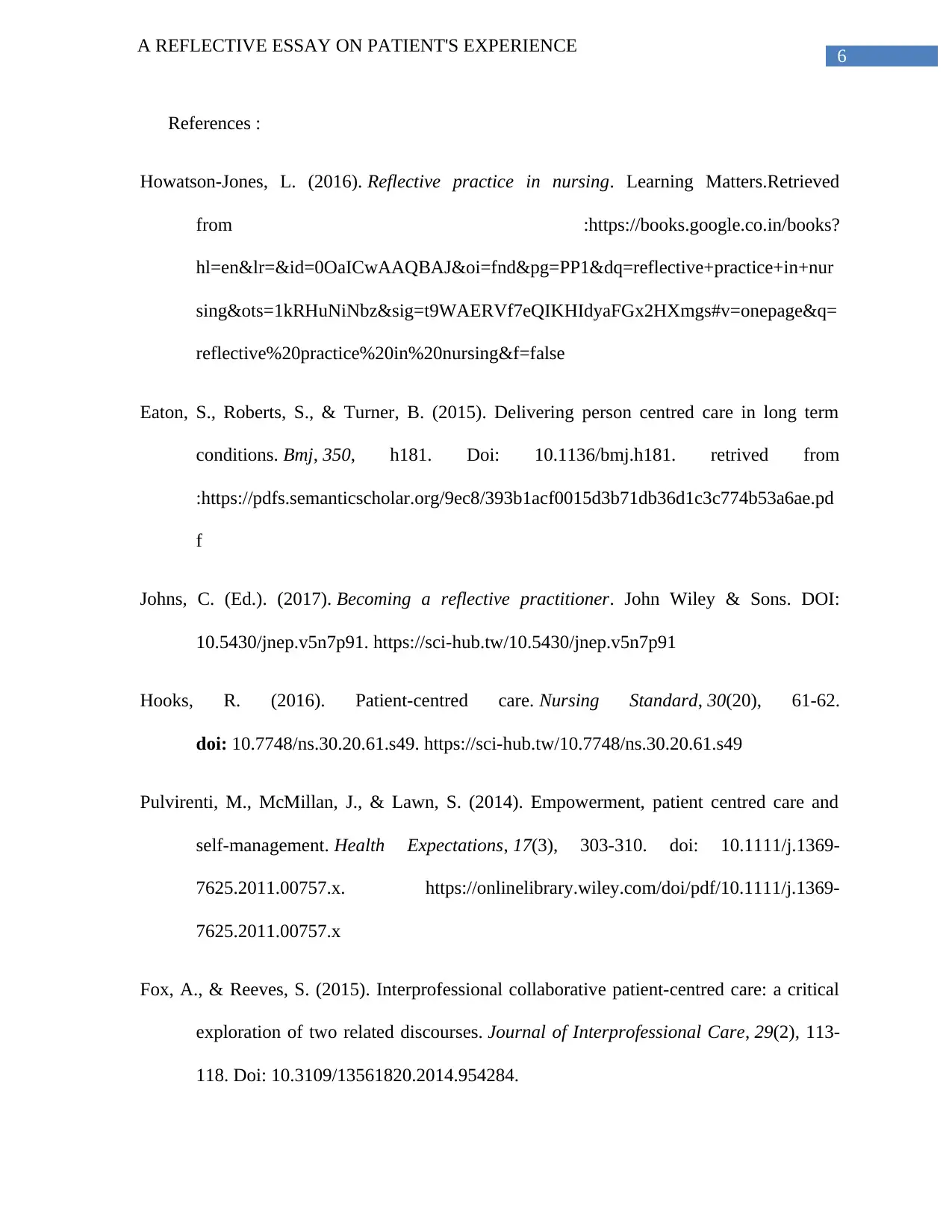
6
A REFLECTIVE ESSAY ON PATIENT'S EXPERIENCE
References :
Howatson-Jones, L. (2016). Reflective practice in nursing. Learning Matters.Retrieved
from :https://books.google.co.in/books?
hl=en&lr=&id=0OaICwAAQBAJ&oi=fnd&pg=PP1&dq=reflective+practice+in+nur
sing&ots=1kRHuNiNbz&sig=t9WAERVf7eQIKHIdyaFGx2HXmgs#v=onepage&q=
reflective%20practice%20in%20nursing&f=false
Eaton, S., Roberts, S., & Turner, B. (2015). Delivering person centred care in long term
conditions. Bmj, 350, h181. Doi: 10.1136/bmj.h181. retrived from
:https://pdfs.semanticscholar.org/9ec8/393b1acf0015d3b71db36d1c3c774b53a6ae.pd
f
Johns, C. (Ed.). (2017). Becoming a reflective practitioner. John Wiley & Sons. DOI:
10.5430/jnep.v5n7p91. https://sci-hub.tw/10.5430/jnep.v5n7p91
Hooks, R. (2016). Patient-centred care. Nursing Standard, 30(20), 61-62.
doi: 10.7748/ns.30.20.61.s49. https://sci-hub.tw/10.7748/ns.30.20.61.s49
Pulvirenti, M., McMillan, J., & Lawn, S. (2014). Empowerment, patient centred care and
self‐management. Health Expectations, 17(3), 303-310. doi: 10.1111/j.1369-
7625.2011.00757.x. https://onlinelibrary.wiley.com/doi/pdf/10.1111/j.1369-
7625.2011.00757.x
Fox, A., & Reeves, S. (2015). Interprofessional collaborative patient-centred care: a critical
exploration of two related discourses. Journal of Interprofessional Care, 29(2), 113-
118. Doi: 10.3109/13561820.2014.954284.
A REFLECTIVE ESSAY ON PATIENT'S EXPERIENCE
References :
Howatson-Jones, L. (2016). Reflective practice in nursing. Learning Matters.Retrieved
from :https://books.google.co.in/books?
hl=en&lr=&id=0OaICwAAQBAJ&oi=fnd&pg=PP1&dq=reflective+practice+in+nur
sing&ots=1kRHuNiNbz&sig=t9WAERVf7eQIKHIdyaFGx2HXmgs#v=onepage&q=
reflective%20practice%20in%20nursing&f=false
Eaton, S., Roberts, S., & Turner, B. (2015). Delivering person centred care in long term
conditions. Bmj, 350, h181. Doi: 10.1136/bmj.h181. retrived from
:https://pdfs.semanticscholar.org/9ec8/393b1acf0015d3b71db36d1c3c774b53a6ae.pd
f
Johns, C. (Ed.). (2017). Becoming a reflective practitioner. John Wiley & Sons. DOI:
10.5430/jnep.v5n7p91. https://sci-hub.tw/10.5430/jnep.v5n7p91
Hooks, R. (2016). Patient-centred care. Nursing Standard, 30(20), 61-62.
doi: 10.7748/ns.30.20.61.s49. https://sci-hub.tw/10.7748/ns.30.20.61.s49
Pulvirenti, M., McMillan, J., & Lawn, S. (2014). Empowerment, patient centred care and
self‐management. Health Expectations, 17(3), 303-310. doi: 10.1111/j.1369-
7625.2011.00757.x. https://onlinelibrary.wiley.com/doi/pdf/10.1111/j.1369-
7625.2011.00757.x
Fox, A., & Reeves, S. (2015). Interprofessional collaborative patient-centred care: a critical
exploration of two related discourses. Journal of Interprofessional Care, 29(2), 113-
118. Doi: 10.3109/13561820.2014.954284.
Paraphrase This Document
Need a fresh take? Get an instant paraphrase of this document with our AI Paraphraser
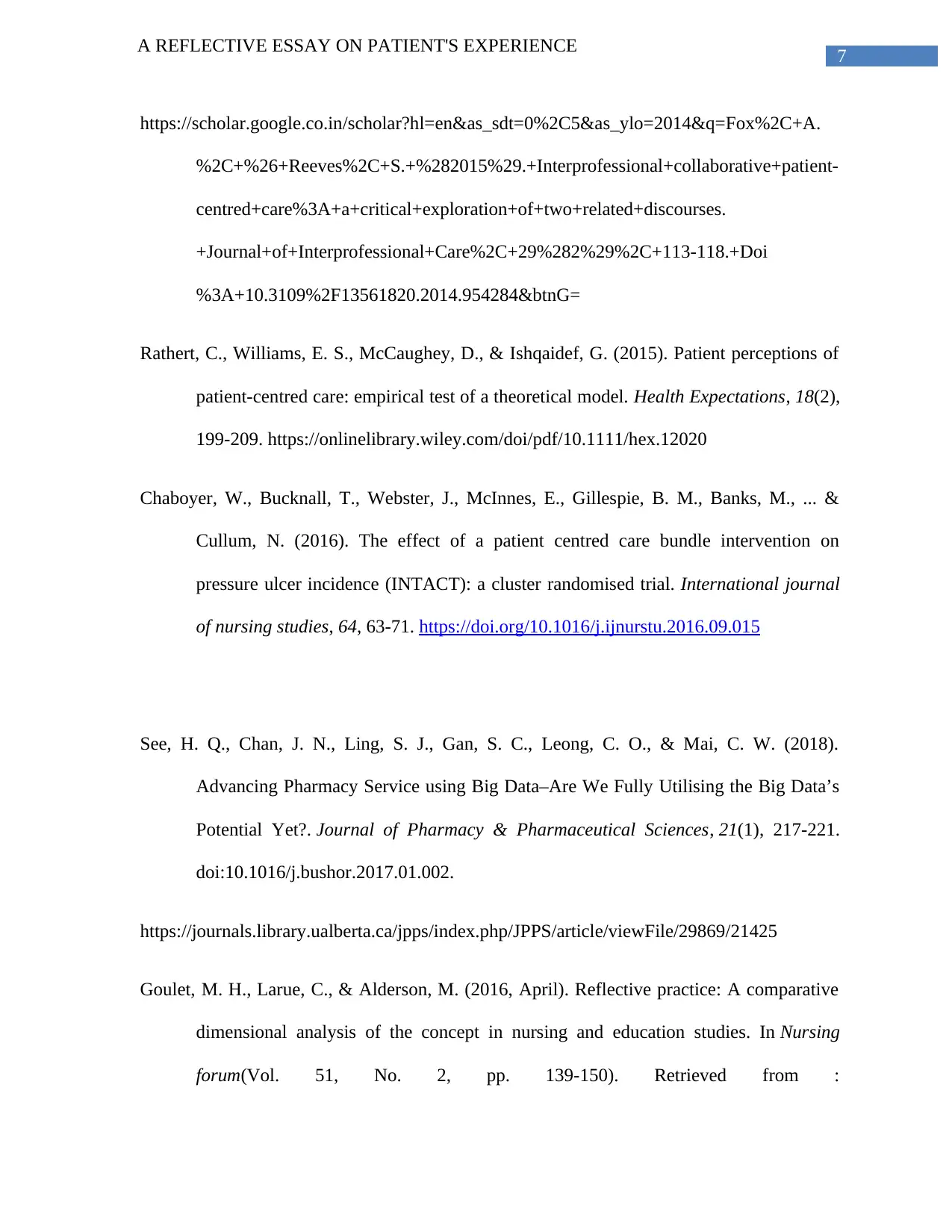
7
A REFLECTIVE ESSAY ON PATIENT'S EXPERIENCE
https://scholar.google.co.in/scholar?hl=en&as_sdt=0%2C5&as_ylo=2014&q=Fox%2C+A.
%2C+%26+Reeves%2C+S.+%282015%29.+Interprofessional+collaborative+patient-
centred+care%3A+a+critical+exploration+of+two+related+discourses.
+Journal+of+Interprofessional+Care%2C+29%282%29%2C+113-118.+Doi
%3A+10.3109%2F13561820.2014.954284&btnG=
Rathert, C., Williams, E. S., McCaughey, D., & Ishqaidef, G. (2015). Patient perceptions of
patient‐centred care: empirical test of a theoretical model. Health Expectations, 18(2),
199-209. https://onlinelibrary.wiley.com/doi/pdf/10.1111/hex.12020
Chaboyer, W., Bucknall, T., Webster, J., McInnes, E., Gillespie, B. M., Banks, M., ... &
Cullum, N. (2016). The effect of a patient centred care bundle intervention on
pressure ulcer incidence (INTACT): a cluster randomised trial. International journal
of nursing studies, 64, 63-71. https://doi.org/10.1016/j.ijnurstu.2016.09.015
See, H. Q., Chan, J. N., Ling, S. J., Gan, S. C., Leong, C. O., & Mai, C. W. (2018).
Advancing Pharmacy Service using Big Data–Are We Fully Utilising the Big Data’s
Potential Yet?. Journal of Pharmacy & Pharmaceutical Sciences, 21(1), 217-221.
doi:10.1016/j.bushor.2017.01.002.
https://journals.library.ualberta.ca/jpps/index.php/JPPS/article/viewFile/29869/21425
Goulet, M. H., Larue, C., & Alderson, M. (2016, April). Reflective practice: A comparative
dimensional analysis of the concept in nursing and education studies. In Nursing
forum(Vol. 51, No. 2, pp. 139-150). Retrieved from :
A REFLECTIVE ESSAY ON PATIENT'S EXPERIENCE
https://scholar.google.co.in/scholar?hl=en&as_sdt=0%2C5&as_ylo=2014&q=Fox%2C+A.
%2C+%26+Reeves%2C+S.+%282015%29.+Interprofessional+collaborative+patient-
centred+care%3A+a+critical+exploration+of+two+related+discourses.
+Journal+of+Interprofessional+Care%2C+29%282%29%2C+113-118.+Doi
%3A+10.3109%2F13561820.2014.954284&btnG=
Rathert, C., Williams, E. S., McCaughey, D., & Ishqaidef, G. (2015). Patient perceptions of
patient‐centred care: empirical test of a theoretical model. Health Expectations, 18(2),
199-209. https://onlinelibrary.wiley.com/doi/pdf/10.1111/hex.12020
Chaboyer, W., Bucknall, T., Webster, J., McInnes, E., Gillespie, B. M., Banks, M., ... &
Cullum, N. (2016). The effect of a patient centred care bundle intervention on
pressure ulcer incidence (INTACT): a cluster randomised trial. International journal
of nursing studies, 64, 63-71. https://doi.org/10.1016/j.ijnurstu.2016.09.015
See, H. Q., Chan, J. N., Ling, S. J., Gan, S. C., Leong, C. O., & Mai, C. W. (2018).
Advancing Pharmacy Service using Big Data–Are We Fully Utilising the Big Data’s
Potential Yet?. Journal of Pharmacy & Pharmaceutical Sciences, 21(1), 217-221.
doi:10.1016/j.bushor.2017.01.002.
https://journals.library.ualberta.ca/jpps/index.php/JPPS/article/viewFile/29869/21425
Goulet, M. H., Larue, C., & Alderson, M. (2016, April). Reflective practice: A comparative
dimensional analysis of the concept in nursing and education studies. In Nursing
forum(Vol. 51, No. 2, pp. 139-150). Retrieved from :
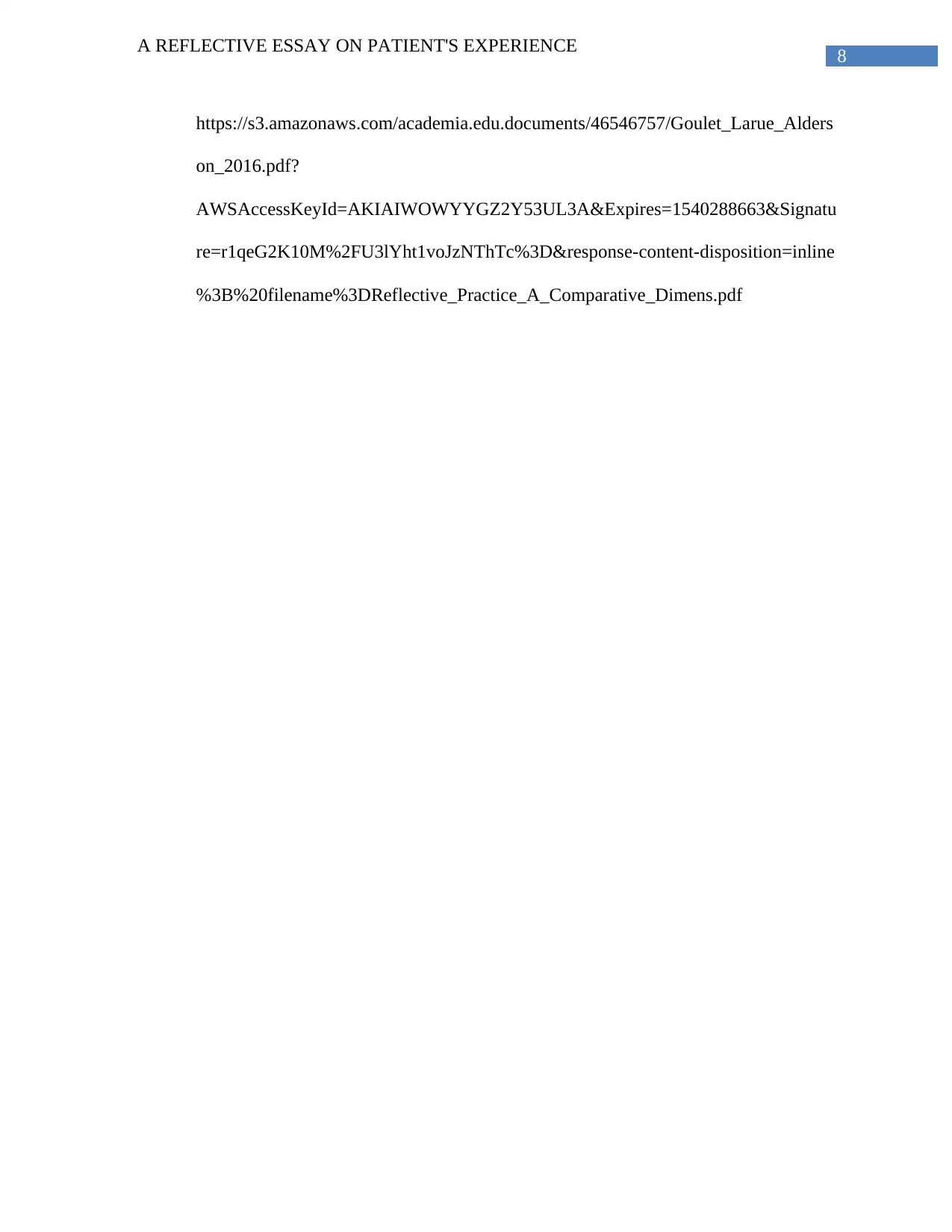
8
A REFLECTIVE ESSAY ON PATIENT'S EXPERIENCE
https://s3.amazonaws.com/academia.edu.documents/46546757/Goulet_Larue_Alders
on_2016.pdf?
AWSAccessKeyId=AKIAIWOWYYGZ2Y53UL3A&Expires=1540288663&Signatu
re=r1qeG2K10M%2FU3lYht1voJzNThTc%3D&response-content-disposition=inline
%3B%20filename%3DReflective_Practice_A_Comparative_Dimens.pdf
A REFLECTIVE ESSAY ON PATIENT'S EXPERIENCE
https://s3.amazonaws.com/academia.edu.documents/46546757/Goulet_Larue_Alders
on_2016.pdf?
AWSAccessKeyId=AKIAIWOWYYGZ2Y53UL3A&Expires=1540288663&Signatu
re=r1qeG2K10M%2FU3lYht1voJzNThTc%3D&response-content-disposition=inline
%3B%20filename%3DReflective_Practice_A_Comparative_Dimens.pdf
1 out of 9
Related Documents
Your All-in-One AI-Powered Toolkit for Academic Success.
+13062052269
info@desklib.com
Available 24*7 on WhatsApp / Email
![[object Object]](/_next/static/media/star-bottom.7253800d.svg)
Unlock your academic potential
© 2024 | Zucol Services PVT LTD | All rights reserved.





